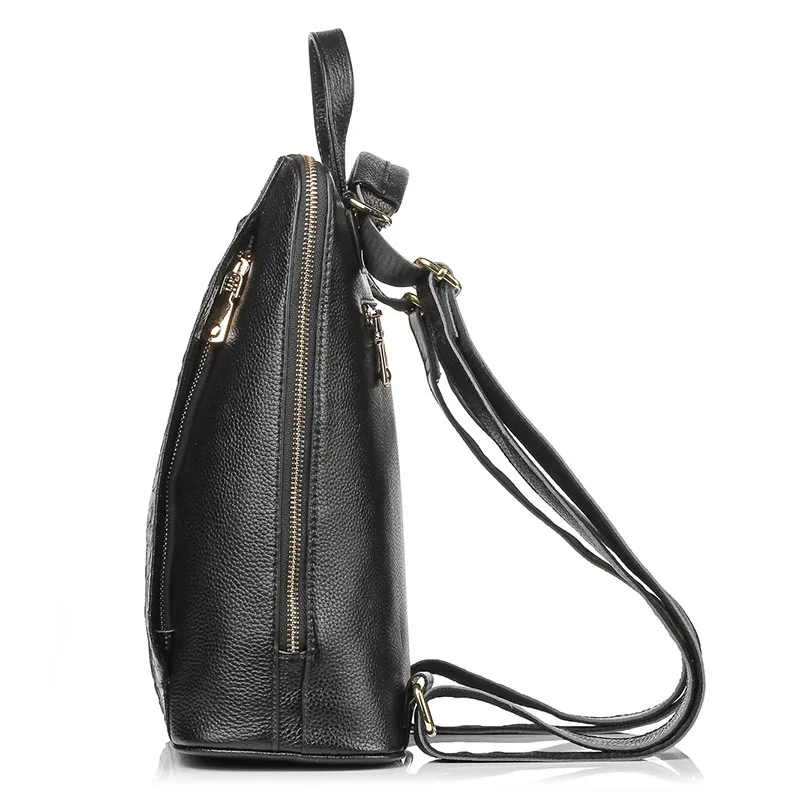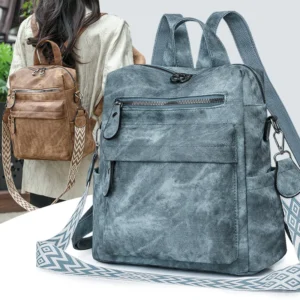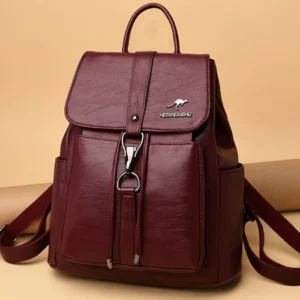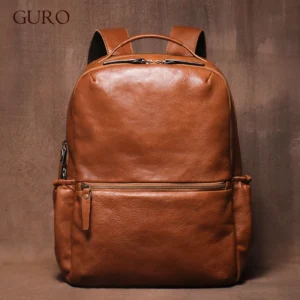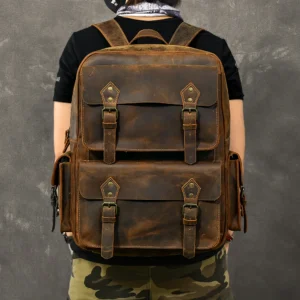Introduction: The Petite Backpack Predicament
Finding the perfect backpack when you’re petite can feel like searching for a needle in a haystack. Standard backpack designs often overwhelm smaller frames, creating an unbalanced look and uncomfortable carrying experience. For those with petite frames (typically under 5‘4” or 163 cm), the challenge goes beyond just finding something cute—it’s about finding something that actually fits properly.
What many don’t realize is that torso length matters more than overall height when it comes to backpack fit. Even someone of average height can have a shorter torso, making them “functionally petite” for backpack purposes. When a backpack is too large, it doesn’t just look awkward—it can cause back pain, shoulder strain, and general discomfort.
Leather backpacks offer unique advantages for petite individuals. The material molds to your body over time, can be found in both structured and unstructured varieties, and tends to age beautifully. With proper sizing, a quality leather backpack can be both flattering and functional for smaller frames.
Many petite individuals share common frustrations: backpacks that hang too low, straps that never seem to adjust short enough, or designs that make them look like they’re carrying their older sibling’s bag. This guide aims to solve these problems by helping you find a leather backpack with ideal proportions, comfort, and style specifically designed for your petite frame.
Finding properly sized compact leather backpacks for women doesn’t have to be frustrating when you understand what to look for.
Understanding Proportions: Why Size Matters for Petite Frames
When it comes to backpacks for petite frames, proportion is everything. An oversized backpack doesn’t just feel uncomfortable—it creates a visual imbalance that can make you appear even smaller than you are. Think of your backpack as part of your overall silhouette; when properly scaled, it enhances rather than overwhelms your frame.
The key concept here is visual weight. A backpack that’s too large draws attention to itself rather than creating a harmonious look with your body. Professional stylists often use the principle of proportional accessories when working with petite clients, recommending bags that complement rather than compete with the wearer’s stature.
Beyond aesthetics, properly scaled backpacks distribute weight more effectively across a smaller frame, reducing strain and improving comfort. When examining ultimate guide to small leather backpacks, you’ll discover that proportion affects not just how you look, but how you feel throughout the day.
Torso Length: Your Most Crucial Measurement
Understanding your torso length is the foundation of finding a perfectly fitting backpack. Unlike overall height, torso length directly determines where a backpack will sit on your body and how comfortable it will be.
How to measure your torso:
- Stand straight with your chin parallel to the floor
- Find your C7 vertebra (the bony bump at the base of your neck when you tilt your head forward)
- Locate your iliac crest (the top of your hip bones) by placing your hands on your hips
- Ask someone to measure the distance between these two points along your spine
- This measurement is your torso length
For petite individuals, torso length typically falls between 14-16 inches (35-40 cm). This measurement is crucial because it helps determine the maximum height your backpack should be. Ideally, your backpack shouldn’t exceed 75-80% of your torso length to maintain proper proportion.
Our collection of small leather backpacks features options specifically designed with these proportions in mind, ensuring a better fit for petite frames.
The “Rule of Thirds” for Backpacks on Petite Frames
Fashion photographers and stylists often use the “rule of thirds” to create visually pleasing compositions—and this principle applies perfectly to backpack proportions for petite frames.
For optimal visual balance, your backpack should:
– Not extend below your waistline
– Not exceed the width of your torso
– Ideally occupy the middle third of your back when worn
When this rule is followed, the backpack creates a harmonious proportion with your body. When broken, the backpack can appear to be wearing you rather than the other way around. The ideal backpack should enhance your silhouette, not overwhelm it or create visual heaviness.
Fashion photographers regularly use this principle when shooting accessories because it creates natural visual harmony. For petite frames, this means a backpack height that’s approximately 2/3 of your torso length often creates the most flattering proportion.
Volume (Liters) Demystified for Petite Users
Backpack capacity is typically measured in liters, but what does that mean practically for petite frames? Here’s how to translate those numbers into real-world utility:
| Usage | Recommended Volume for Petite Frames | Standard Recommendation | Contains |
|---|---|---|---|
| Everyday Carry | 8-15 liters | 15-20 liters | Essentials, small water bottle, compact umbrella |
| Work/School | 12-20 liters | 20-30 liters | Laptop, documents, lunch, water bottle |
| Travel/Overnight | 18-25 liters | 25-35 liters | Change of clothes, toiletries, essentials |
When shopping, pay attention to how volume is distributed. Some backpacks expand outward (adding width), while others expand upward (adding height). For petite frames, backpacks that distribute volume vertically rather than horizontally typically create a more flattering silhouette.
Our mini leather backpack collection offers perfectly proportioned options with smart volume distribution specifically designed for petite frames.
Ideal Leather Backpack Shapes for Petite Frames
The shape of your leather backpack significantly influences how it looks on your frame. Certain silhouettes naturally complement petite proportions, creating visual harmony rather than overwhelming your stature.
Shape doesn’t just affect appearance—it directly impacts functionality too. The right shape balances your need for capacity with a proportional look. With leather backpacks, shape takes on additional importance because the material’s properties (structure, flexibility, and aging characteristics) interact with the design to create the overall visual impact.
Understanding different leather backpack styles explained helps you recognize how subtle differences in shape can dramatically change both function and appearance on a petite frame.
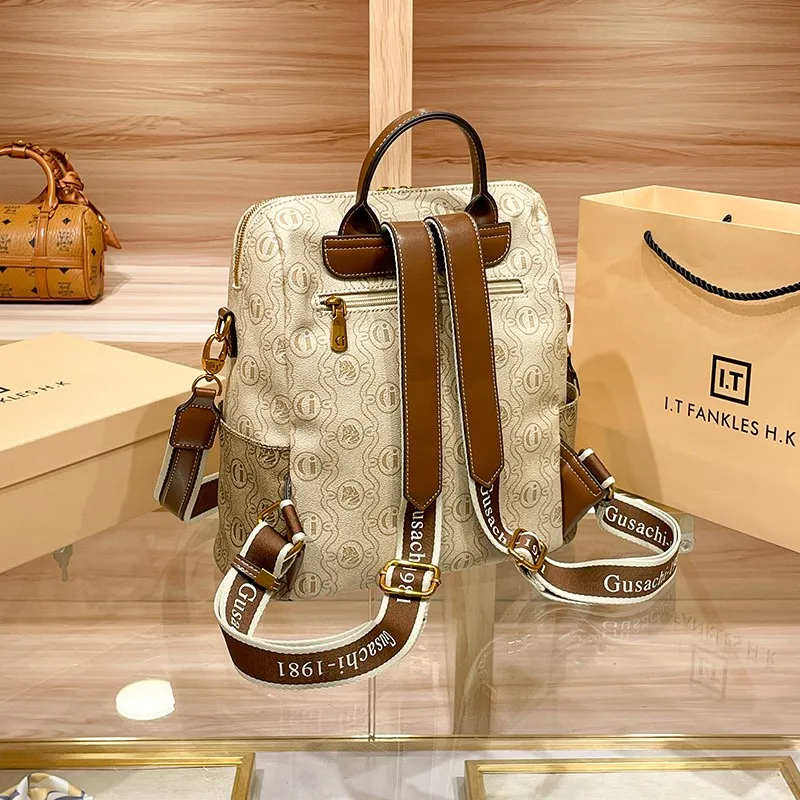
Mini & Small Backpacks: Naturally Proportionate Options
Mini and small backpacks are often the most naturally flattering options for petite frames. Typically measuring 9-12 inches (23-30 cm) in height with a capacity of 8-15 liters, these backpacks create balanced proportions without sacrificing essential functionality.
Benefits for petite frames include:
– Natural proportion that doesn’t overwhelm your silhouette
– Lighter weight that reduces strain on smaller shoulders
– Encourages mindful packing of true essentials
– Versatility for various occasions
While capacity is more limited, high-quality leather maximizes functionality through durability and intelligent design. Premium leather also maintains structure better than synthetic materials, helping these smaller bags hold their shape even when full.
These smaller backpacks typically accommodate daily essentials including a small water bottle, compact umbrella, wallet, phone, keys, and small makeup items. For work, many can fit tablets or small laptops (up to 13”), making them surprisingly practical for everyday use.
For petite individuals seeking properly proportioned options, exploring small leather backpacks for women provides excellent starting points with appropriately scaled designs.
Slim Rectangular & Columnar Shapes: Vertical Elegance
Slim rectangular and columnar backpack shapes create a vertically oriented silhouette that naturally complements petite frames. These designs emphasize height rather than width, creating an elongating effect that works harmoniously with smaller statures.
Ideal dimensions for these shapes typically include:
– Width: 8-11 inches (20-28 cm)
– Height: 12-16 inches (30-40 cm)
– Depth: 3-5 inches (7.5-12.5 cm)
– Optimal width-to-height ratio: approximately 2:3 or 1:2
These vertically oriented shapes avoid adding visual width to your silhouette, preventing that overwhelming effect common with wider backpacks. They’re particularly well-suited for professional environments where a sleek, sophisticated profile is desired.
The leather type dramatically impacts how these shapes wear. Firmer, more structured leather maintains the clean lines of these silhouettes, while softer leather creates a more relaxed vertical drape that still retains the elongating effect.
Structured vs. Unstructured Leather Backpacks
The degree of structure in a leather backpack significantly impacts how it sits on a petite frame, with both structured and unstructured options offering unique advantages:
| Aspect | Structured Leather Backpacks | Unstructured Leather Backpacks |
|---|---|---|
| Visual Impact | Maintains shape regardless of contents | Conforms to body and contents |
| Perceived Size | Can appear larger due to defined silhouette | Often appears smaller as it molds to body |
| Weight | Typically heavier | Usually lighter |
| Professional Look | More formal, polished appearance | Casual, relaxed aesthetic |
| Best For Petite Frames When… | Slim profile with vertical orientation | Made from soft, supple leather that drapes well |
The leather quality plays a crucial role in determining structure. Full-grain leather, like those used in our full-grain leather backpack collection, offers excellent structure while developing character over time. The thickness of the leather, tanning method, and interior reinforcement all contribute to how structured the bag remains.
For petite frames, moderately structured backpacks often provide the best balance—maintaining a flattering shape without appearing too rigid or imposing.
Teardrop & Rounded Shapes: Softening the Silhouette
Teardrop and rounded backpack shapes offer a softer alternative to angular designs, often appearing less visually heavy on petite frames. These shapes follow the natural curve of the back, creating a more organic silhouette.
The fluid lines of these designs distribute visual weight more naturally, avoiding the harsh corners that can make a backpack appear larger than it actually is. On petite frames, this curved silhouette often creates a more harmonious proportion.
For optimal fit, look for teardrop or rounded shapes with:
– Height: 10-14 inches (25-35 cm)
– Width at base: 8-10 inches (20-25 cm)
– Width at top: 6-8 inches (15-20 cm)
– Depth: 3-5 inches (7.5-12.5 cm)
Softer, more flexible leather enhances these curved designs by allowing the bag to drape naturally against the body. These shapes also typically distribute weight more comfortably across the back, with the wider bottom portion resting at the lower back where more weight can be comfortably supported.
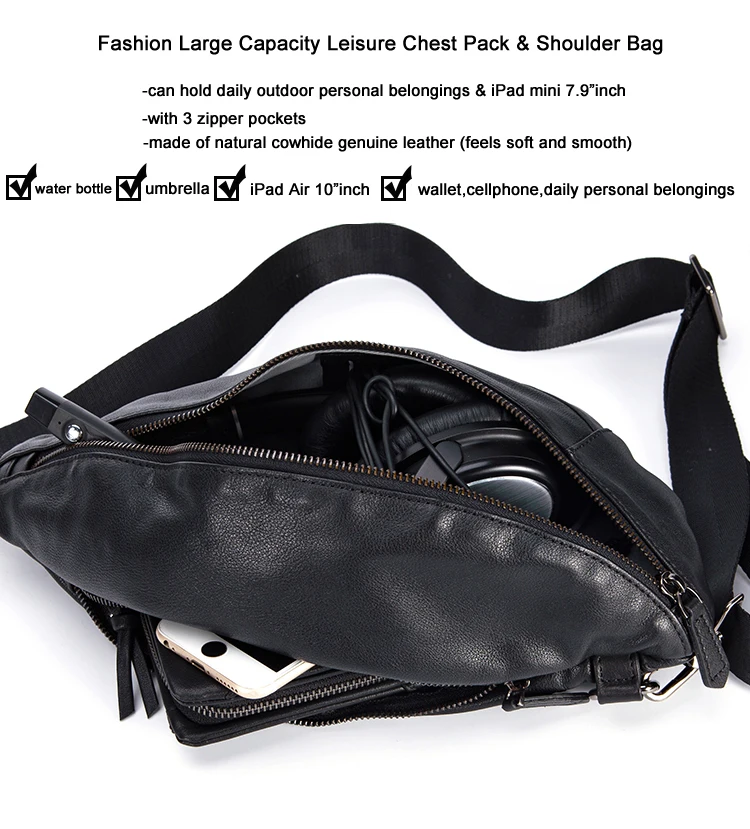
Shapes to Avoid for Petite Frames
Certain backpack shapes consistently overwhelm petite frames, creating visual imbalance and discomfort. Being aware of these problematic designs helps you avoid common pitfalls:
- Excessively wide backpacks (wider than 12 inches/30 cm): Create a disproportionate silhouette that extends beyond shoulder width
- Deep, bulky designs (deeper than 6 inches/15 cm): Add unnecessary bulk that projects too far from the back
- Large square shapes: Create a boxy look that conflicts with the body’s natural curves
- Oversized flap tops: Add visual height and bulk in the upper portion of the bag
- Bottom-heavy designs: Create a drooping appearance and unbalanced weight distribution
Instead of these overwhelming shapes, the benefits of compact bags for modern life include better proportion, improved comfort, and a more streamlined appearance that works harmoniously with petite frames.
Key Features for a Perfect Petite Fit
Beyond shape and size, specific features can dramatically improve how a backpack fits a petite frame. These design elements often make the difference between a bag that merely looks good and one that truly fits well.
Even the most perfectly proportioned backpack can fail without thoughtful feature design. Adjustability, ergonomics, and strategic organization all contribute to creating a backpack that works harmoniously with smaller frames.
Understanding important design features in women’s leather backpacks helps you identify quality elements that enhance comfort and function specifically for petite users.
Adjustable Straps: A Non-Negotiable Feature
For petite frames, truly adjustable straps aren’t just a nice feature—they’re essential. Many standard backpacks don’t adjust short enough for petite torsos, leaving excess strap dangling or the bag sitting too low.
Ideal strap adjustment for petite frames should allow:
– Minimum adjusted length that places the top of the bag at mid-shoulder blade
– Maximum adjusted length for occasional wearing over bulky outerwear
– Secure strap adjusters that don’t slip over time
– Built-in strap management for excess material
Leather straps require special consideration as they typically stretch and soften with use. When new, adjust them slightly shorter than seems necessary to account for natural stretching over time.
For excess strap material, look for built-in management systems like elastic loops or adjustable sliders. Alternatively, leather strap wraps can be added as an aftermarket solution to manage longer straps without dangling ends.
Ergonomic Strap Design: Comfort for Smaller Shoulders
Petite frames benefit from thoughtfully designed straps that account for narrower shoulders and shorter torsos. The ideal strap width for petite shoulders typically ranges from 1-1.5 inches (2.5-3.8 cm)—wide enough to distribute weight comfortably without overwhelming smaller frames.
Key elements of ergonomic strap design include:
– Curved shape that follows shoulder contours
– Padding that’s sufficient without being bulky
– Strategic placement on the bag for proper weight distribution
– Appropriate spacing between straps (not too wide for narrow shoulders)
Optional sternum straps can significantly improve comfort for petite frames by preventing the shoulder straps from sliding outward. When included, the sternum strap should be fully adjustable both vertically and horizontally to accommodate different torso lengths.
Top Handles: Added Versatility for Petite Users
Top handles provide valuable versatility for petite users, offering an alternative carrying option when backpack-style doesn’t suit the situation. For petite frames, the ideal handle drop length is typically 2-3 inches (5-7.6 cm)—enough to grip comfortably without adding unnecessary bulk.
Top handles prove particularly useful when:
– Navigating crowded spaces where a backpack might extend too far
– Quickly grabbing the bag from storage or a car seat
– Creating a more professional look in formal settings
– Resting the shoulders during long days of wear
Quality leather handles should be securely attached to the backpack’s main structure, not merely the outer layer. Reinforced stitching and proper backing ensure handles can support the bag’s weight even when fully loaded.
Smart External Pockets & Organization
Thoughtful organization can significantly impact a backpack’s visual proportion and practical functionality for petite users. The key is balancing accessibility with a sleek profile.
For petite-friendly organization:
– Favor vertical pocket placement over horizontal expansion
– Choose flat pockets over bulging ones when possible
– Look for interior dividers that maximize space efficiency
– Consider bags with expandable/collapsible external pockets
– Prioritize organization systems that maintain a sleek profile
The mastering small leather backpack organization approach focuses on maximizing internal space while maintaining clean external lines. This balance is particularly important for petite frames where excess bulk quickly becomes visually overwhelming.
Hardware & Zippers: The Impact of Details
Hardware may seem like a minor detail, but its size, weight, and placement significantly impact both comfort and aesthetics for petite frames.
For optimal proportion:
– Choose backpacks with appropriately sized hardware (avoid oversized buckles or clasps)
– Consider hardware weight—heavy metal components add unnecessary bulk
– Look for quality zippers with smooth operation that don’t require excessive force
– Favor subtle hardware finishes that integrate with the leather color rather than creating stark contrast
High-quality hardware should be proportional to the bag size, functionally smooth, and visually integrated with the overall design. For petite frames, oversized decorative hardware quickly becomes visually dominant and physically uncomfortable.
Leather Type & Aesthetic Considerations for Petite Frames
The type of leather used in a backpack dramatically affects how it drapes, weighs, and appears on a petite frame. Understanding these differences helps you select a leather type that enhances rather than overwhelms your proportions.
| Leather Type | Weight | Structure | Drape | Best For Petite Frames When… |
|---|---|---|---|---|
| Full-grain | Heaviest | Most structured | Minimal | In slim, compact designs |
| Top-grain | Medium | Moderate | Moderate | Seeking balance of structure and flexibility |
| Split-grain | Lighter | Less structured | Good | Wanting a softer, more conforming fit |
| Vegan leather | Varies | Varies | Varies | Choosing thinner, more flexible options |
Beyond physical properties, leather weight directly impacts comfort for petite frames. A heavy leather backpack can quickly become uncomfortable, regardless of proper sizing. For everyday use, seek backpacks using lighter weight leathers or those where the design minimizes unnecessary material.
With proper care, quality leather backpacks develop a beautiful patina over time while maintaining their structural integrity. This longevity makes them excellent investment pieces despite their higher initial cost compared to synthetic alternatives.
Color and Finish: Visual Impact on Perceived Size
Color and finish choices significantly influence how large a backpack appears on a petite frame. These visual elements can either enhance or detract from proper proportion.
Generally speaking:
– Darker colors (black, deep brown, navy) create a more streamlined, compact appearance
– Lighter colors tend to make objects appear larger and draw more visual attention
– Matte finishes typically appear more subtle than high-gloss options
– Consistent color throughout appears more streamlined than high-contrast color blocking
For many petite individuals, black leather backpacks offer a versatile option that creates a sleek visual profile while pairing easily with various outfits. Black leather also tends to minimize the appearance of external features and hardware, creating a more cohesive silhouette.
The finish of the leather also impacts perceived size—high-gloss finishes reflect more light, drawing attention and often making the backpack appear more prominent, while matte or semi-matte finishes create a more subdued look.
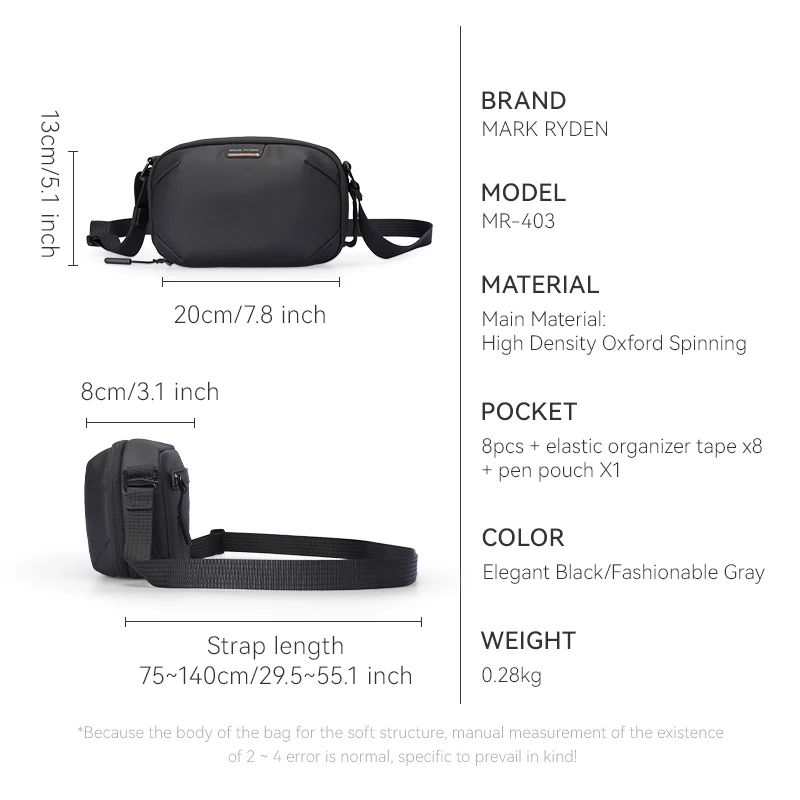
Solving Common Petite Backpack Problems
Petite individuals frequently encounter specific challenges when using backpacks. Fortunately, understanding the causes of these issues leads to effective solutions that enhance both comfort and appearance.
Many common problems stem from using backpacks designed for average frames without considering the unique proportions of petite bodies. The good news is that with proper selection and adjustment, these issues can be resolved, transforming your backpack experience from frustrating to fantastic.
“My Straps Always Fall Off or Dig In”
This common complaint typically stems from strap design that doesn’t account for narrower shoulders or shorter torsos.
Why it happens: Standard straps are often set too wide apart for petite shoulders, causing them to slip off. Alternatively, straps that don’t adjust short enough cause the bag to hang too low, creating pressure points.
Solutions:
– Choose backpacks with straps positioned closer together at the top attachment point
– Look for curved strap designs that follow shoulder contours
– Select narrower straps (1-1.5 inches/2.5-3.8 cm) that better fit petite shoulders
– Use sternum straps when available to prevent slipping
– Consider backpacks designed specifically for smaller frames
Leather straps typically become more comfortable over time as they conform to your body. During the break-in period, wearing the backpack for shorter durations helps the leather mold to your specific shoulder shape.
“The Backpack Looks Like It’s Swallowing Me”
This visual proportion problem occurs when a backpack is simply too large for your frame, creating an unbalanced appearance.
Why it happens: Many standard backpacks are designed for average height individuals with longer torsos, creating disproportionate scale on petite frames.
Solutions:
– Select backpacks with height proportional to your torso length (generally not exceeding 75-80% of your torso measurement)
– Choose vertically oriented designs rather than wide, boxy shapes
– Opt for slim profiles that don’t extend beyond your shoulder width
– Consider mini or small backpacks specifically designed for petite proportions
– Adjust straps properly so the backpack sits at the appropriate height
Taking a photo of yourself wearing the backpack (both front and side view) often reveals proportion issues that aren’t obvious in a mirror, helping you assess fit more objectively.
“It Feels Too Heavy or Uncomfortable”
Weight and comfort issues are particularly problematic for petite frames, which have less surface area to distribute the backpack’s weight.
Why it happens: Petite frames have shorter torsos and narrower shoulders, providing less area for weight distribution. Additionally, standard backpacks often place weight incorrectly for shorter torsos.
Solutions:
– Select lightweight leather bags designed with weight-saving construction
– Choose backpacks with empty weights under 2-3 pounds (0.9-1.4 kg)
– Look for designs with padded back panels that enhance comfort
– Ensure weight distribution sits primarily at mid-back rather than lower back
– Consider backpacks with chest straps for improved weight distribution
– Be realistic about capacity needs—choose the smallest functional size
Designer Mini Backpack, Mini Leather Backpack, Small Leather Sling Backpack, Women's Leather Backpack
Price range: $95.76 through $98.80 Select options This product has multiple variants. The options may be chosen on the product pageDesigner Mini Backpack, Designer Women's Backpack, Mini Leather Backpack, Women's Leather Backpack
Price range: $135.92 through $137.64 Select options This product has multiple variants. The options may be chosen on the product pageBlack Leather Backpack, Small Leather Backpack, Women's Leather Backpack
Price range: $112.96 through $116.12 Select options This product has multiple variants. The options may be chosen on the product pageLuxury Leather Backpack, Small Leather Backpack, Women's Leather Backpack
Price range: $137.48 through $138.28 Select options This product has multiple variants. The options may be chosen on the product pageFull Grain Leather Backpack, Men's Leather Laptop Backpack, Men's Leather Work Backpack
$353.46 Select options This product has multiple variants. The options may be chosen on the product page17 Inch Leather Laptop Backpack, Full Grain Leather Backpack, Men's Leather Backpack, Men's Leather Travel Backpack, Vintage Leather Backpack
Price range: $234.91 through $284.86 Select options This product has multiple variants. The options may be chosen on the product page
Even high-quality leather backpacks have a break-in period. The leather will soften and conform to your body shape over time, typically becoming noticeably more comfortable after a few weeks of regular use.
Finding Your Perfect Leather Backpack: Actionable Steps
Ready to find your ideal leather backpack? Follow these five steps to ensure you select a bag that perfectly complements your petite frame:
Measure your torso length accurately before shopping
– Use the measurement technique described earlier (C7 vertebra to iliac crest)
– Record this measurement and use it as your primary reference point
– Remember that backpack height should generally not exceed 75-80% of your torso lengthPrioritize fit and proportion over brand or trends
– Focus first on backpacks that meet your size requirements
– Consider shape and proportion before aesthetic details
– Remember that even an expensive designer bag looks wrong if it’s disproportionate to your frameTest with realistic weight
– When trying backpacks, add weight similar to what you’ll typically carry
– Walk around for at least 5-10 minutes to assess comfort
– Check for pressure points, strap slippage, or uncomfortable rubbingMatch to your primary use case
– For everyday: Consider 8-15 liter capacity in a versatile shape
– For work/school: Look for 12-20 liter capacity with appropriate laptop storage
– For travel: Select 18-25 liter capacity with versatile organizationSeek petite-specific recommendations
– Ask retailers specifically about options for petite frames
– Look for brands that offer size ranges rather than one-size-fits-all
– Consider user reviews from other petite individuals
When shopping online, pay special attention to all dimensions (height, width, depth) rather than just capacity. Many retailers provide model height information in product photos, which can help you gauge proportion. For the best small leather backpacks for city trips, focus on compact designs that balance aesthetics with practical urban functionality.
Supplemental Content: Beyond the Basics
Are Designer Leather Backpacks Worth It for Petite Frames?
When considering investment in a designer leather backpack for a petite frame, the value proposition requires careful evaluation.
Pros:
– Higher-end brands often use premium leathers that are both lighter and more durable
– Designer pieces frequently offer more refined proportions and attention to detail
– Quality construction typically means better weight distribution and ergonomics
– Superior materials generally age better and develop more beautiful patina
– Resale value tends to be stronger for well-maintained designer pieces
Cons:
– Many luxury brands still design primarily for average heights
– Premium pricing doesn’t always guarantee petite-friendly proportions
– Some designer backpacks prioritize trend-forward designs over ergonomic function
– Weight can be an issue with heavily embellished designer pieces
When exploring designer mini backpacks, focus on brands known for attention to proportion and ergonomic design rather than just fashion-forward aesthetics. The best investment pieces combine quality materials with thoughtful proportions specifically suited to petite frames.
How Do I Style a Leather Backpack Without Looking Like a Student?
Leather backpacks can absolutely project sophistication rather than a student aesthetic when styled thoughtfully:
- For professional settings:
- Choose structured leather in classic colors (black, cognac, navy)
- Wear the backpack properly positioned rather than hanging low
- Consider a convertible backpack that transforms into a tote or satchel
Pair with polished, professional attire in complementary colors
For elevated casual looks:
- Select backpacks with minimal exterior branding or logos
- Choose hardware finishes that match your typical jewelry tone
- Coordinate leather color with shoes or belt for a cohesive look
Consider texture mixing (smooth leather backpack with textured clothing)
For evening or special occasions:
- Opt for mini backpacks in luxurious leather finishes
- Consider unexpected colors beyond basic black
- Look for subtle special details like distinctive hardware or unique silhouettes
- Carry as a hand-held bag using top handle for more formal settings
Exploring leather backpack styling with casual outfits provides additional inspiration for creating sophisticated looks that move well beyond student associations.
The right leather backpack for your petite frame combines proper proportion, thoughtful features, and quality materials to create a piece that’s not just functional but truly flattering. By understanding the principles outlined in this guide, you’ll be equipped to find a backpack that complements rather than overwhelms your petite frame, creating both comfort and style for years to come.
